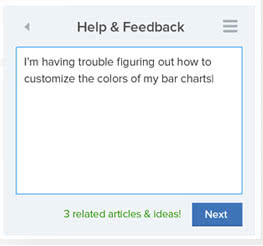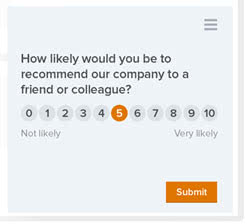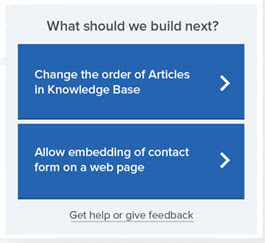Help Desk
Behind the Software with UserVoice CEO Richard White

For many companies, customers are the lynchpin of success. But are you really making the most of these critical relationships? UserVoice wants to get you out from behind the help desk and in front of customers with a suite of tools designed to encourage engagement and yield valuable, actionable data from support interactions. We chatted with founder and CEO Richard White about how Reddit inspired a new breed of customer support, and why UserVoice is poised to blow traditional help desk solutions out of the water.
What was your primary goal in building UserVoice? What was the “ah-ha!” moment where you decided that you needed to create something for this sector?
Prior to UserVoice, I was working on a number of SaaS companies myself, most notably with a Y Combinator company called Kiko. We were a small team, and yet we had a very large freemium audience, and we just found it really difficult to use existing tools, message boards, Wiki, and e-mail to communicate with that audience about product development and other issues. We found that a lot of tech was built for more of a one-to-one communication. We were four guys running a company that had 5000 daily active users, and it just wasn’t possible to have a one-to-one conversation with everyone. At the time, we had friends at this company called Reddit that allows users to submit social content and bubble up what’s most useful. UserVoice was originally kind of a Reddit for customer feedback. Obviously Reddit is a big place these days, and it didn’t work for customer feedback to begin with, so we had to tweak it quite a bit. Now we’re getting back to our roots and launching a new set of tools to help companies, specifically app and freemium companies, which are now far more prevalent than they were five years ago when we started.
Why don’t you tell me a little bit about your launch, and what we can expect from your new product?
We just launched Touchpoint Toolkit, a whole new suite of tools to drive customer engagement. Our original products were feedback forums where people go and submit ideas, very Reddit-ish. We came up with a whole new version of how to approach that. Our goal, unlike Reddit, is not to just get to 1 percent of people and get them to drive 95 percent of the content. We want to get to 30 percent of the people. We want to get a third of the user base or even half your user base actively engaged with you. We use support – we have a help desk product that is awesome- but we use the phrase “get out from behind your help desk.” The help desk is an absolutely essential part of your business in terms of reducing churn and being able to support users. However, it’s not going to get you the engagement rates that we think really gets you to know your user base, and really helps you to create a passionate user base that’s helping you build a great product. We want to communicate everything we do with users within your apps, whether they’re web-based or mobile. And so Touchpoint Toolkit is the first version of this new vision of an embeddable UserVoice. In the fall we launched UserVoice iOS, which is a native SDK for iPhone apps. We learned some things from that, which we put back into the Touchpoint Toolkit.
 There are three end-user components and one platform component to this. The first component is called Instant Answers. This is re-imagining the feedback experience, which is, as a customer having something that I want to tell you: “I need help” or “I have product feedback.” In our previous model it was something that looked a lot like a contact form, but we wanted to improve that and make it simpler. That’s what we learned from our iOS and mobile experience. Now when we design things we design with mobile-first thinking, so what we develop has the benefit of being simpler. In this case, Instant Answers is a re-imagining of that contact form experience that starts with single input box. As you type your message, we drive you off to existing content, whether that is knowledge-based articles that the company has curated, or it’s posted on the forum, or other feedback that users have given. For instance, if you tell us you wish we had better Salesforce integration, we return with, “Great, here’s the idea from another user that was asking for that and we’ll let you know when we have updates on it.” If we get past the Instant Answers options, and you have a truly unique question, we can drive it into submit a ticket, propose an idea on the forum. But it’s a much simpler prompt. There’s a little medallion in the bottom right corner of each page that constantly lets you contact the company. You can click it no matter where you are in the app, and you can immediately contact them.
There are three end-user components and one platform component to this. The first component is called Instant Answers. This is re-imagining the feedback experience, which is, as a customer having something that I want to tell you: “I need help” or “I have product feedback.” In our previous model it was something that looked a lot like a contact form, but we wanted to improve that and make it simpler. That’s what we learned from our iOS and mobile experience. Now when we design things we design with mobile-first thinking, so what we develop has the benefit of being simpler. In this case, Instant Answers is a re-imagining of that contact form experience that starts with single input box. As you type your message, we drive you off to existing content, whether that is knowledge-based articles that the company has curated, or it’s posted on the forum, or other feedback that users have given. For instance, if you tell us you wish we had better Salesforce integration, we return with, “Great, here’s the idea from another user that was asking for that and we’ll let you know when we have updates on it.” If we get past the Instant Answers options, and you have a truly unique question, we can drive it into submit a ticket, propose an idea on the forum. But it’s a much simpler prompt. There’s a little medallion in the bottom right corner of each page that constantly lets you contact the company. You can click it no matter where you are in the app, and you can immediately contact them.

The second component is Satisfaction Surveys. These are scores in a net promoter style, such as “How likely would you be to recommend this company to a friend?” We’ve never collected this data before at all. We’ve always been a company focused on getting explicit feedback from the customers. You can go to Google Analytics to get what I call impulsive feedback, to see if people are bouncing off the page or they’re not staying on your site long. We want to actually ask people explicitly how they are feeling and what we could do better. The Satisfaction Surveys feature fills in the gap. When we talk to product managers or support managers, they would say, “I wish I had a single metric where I could see my impact, the bottom line in customer satisfaction.” This feature doesn’t appear to users all the time; the button pops up every 60 days or so. We can help those department heads get feedback and determine what correlates best to greater customer satisfaction. This is very quantitative, and easily can be rolled up and put in reports. A lot of what we’re doing with Toolkit is trying to come up with the stats to really give our customers the stats to prove the ROI of what they’re doing.
Another thing we’re adding, which is probably the most interesting part to me, is called SmartVote. SmartVote is really a completely new way for us to rank product feedback. In our new model, if you go to give feedback, you go into one of our forums and there’s an input box. You type in your idea, and we auto-suggest if it looks like you’re typing this idea that was already submitted. You can then choose to vote for an idea instead of submitting a new one, and then the things voted on the most rise to the top. What we found is that having a prompt and that simplicity of that experience work very well, but we still have to get people onto the forum. So we thought, “What’s a way we can get this product feedback, this user generated product feedback in front of casual users, people who are in the app?” If you gave them existing feedback, they could vet it and tell you, yes, I could absolutely use this, or yes, I prefer this feature versus that feature. Instead of asking for open-ended feedback, we’re asking users to pick between two ideas. We’ve already defined a pool of ideas you want to look at, and then companies can choose to test all ideas that users have given them. Or they might want to just test these 50 things that we’re considering for our next Q3 release. At the end of it, we get a much higher fidelity signal in terms of what is it that the user wants.
One of the challenges you have in a Reddit model where traditional voting can lead to herd behavior is determining whether something on page five has only three votes because it’s a bad idea or an unpopular idea, or just because nobody really got a chance to see it. With SmartVote, you can see the report and know how many times an idea has been viewed. We know how many times it’s won, how many times it’s lost against what other ideas, and so we can apply algorithms that were originally used for ranking chess masters to rank product feedback, and do it in a way that has statistical significance. In our beta testing, we really have improved dramatically the engagement rate, and we’re getting much more casual users engaged through this than we did through our traditional forums, with we’re getting really higher fidelity feedback that is more statistically significant than vote counts.
We can also analyze that data and look at all those existing reports segmented by traits. You can look at what your Satisfaction Scores look like when you look at paid users, or what the top ideas are if you look at free users. With a traditional help desk, you can provide metrics and stats, but you only know the set of things that have come into the help desk. You can only report that, hey we got 10,000 tickets this month, and we responded to 80 percent of them quickly. But you don’t know that 10,000 people was 10,000 tickets for a million users, or for 10,000 users. We’ve bridged this gap and we can target these things to help improve the ROI of our customers, product managers and support managers.
SmartVote seems very interesting. That seems like it’s somewhat in the spirit of projects like Kickstarter, where you’re crowdsourcing innovations and testing the waters to see how much interest you really have for different ideas before you even start working on them.
If you are familiar with the lean startup movement, there’s a lot of movement towards pre-qualifying demand before you build something. We have the tools to communicate very cheaply. Why would you build a feature until you knew that you had 1000 people already waiting for it?
What can you tell us about how mobile accessibility kind of ties into TouchPoint Toolkit? Is this something that’s designed to only be used on mobile, or is it something that’s compatible with all access platforms- desktop, mobile, iPhones, iPads, etc?
Most of our traffic traditionally is what we now call the desktop web. That’s where we started 5 years ago. We started with what was state-of-the-art on the desktop web in 2008 – putting a mail link in your footer that says support, get help, give me feedback. If you open up your traditional app, it still has mail links, which is where the desktop was 4-5 years ago. So, it works as well on desktop, as well as on mobile web. We started in the fall with launching our first native experience, UserVoice for iOS. I think mobile web constitutes about 25 percent of our usage and is growing very quickly, and so Touchpoint is both mobile and desktop.
According to your site, over 110,000 organizations have used UserVoice. What does the typical customer look like? Do you have a specific customer in mind, or is it a one-size-fits-all product?
This platform has been used by a lot of folks. It has been used by large companies internally. It has been used by government agents. But most of our usage, and who we think about when we design our products, are app companies, whether they are web or mobile app companies. This includes both enterprise productivity apps and also gaming. We work less with the e-commerce folks and less with the media companies. We focus specifically on companies who have a user base that logs into their app regularly. We’re a freemium service, so we can start with people as small as one woman in a garage with our free product. Especially with Touchpoint Toolkit, though, there’s value in getting a robust set of tools like UserVoice into your product early on, and there’s no cost to it. What we’re focusing now on is the 20-person, up to a couple hundred-person company or work group. That’s our sweet spot. When we go into larger companies, we tend to sell into business units, into product units anyway. Companies that have dedicated support teams, dedicated project managers, and dedicated IT managers are all struggling with the same problem of, “Hey, we have a healthy, growing business or mobile app with a growing user base, and we’re trying to figure out how to communicate with them and understand them so we can build a better product.”
What have been the biggest challenges in building up your brand? Were there any false starts when it came to maybe figuring out what people really wanted or how the best way to go about creating this suite of applications was?
I think the hardest thing about building the brand is just trying to get the oxygen for it, trying to get your story out, because there are so many people trying to get their own stories out into the marketplace. We’ve been around five years, and I think there was this space between late 2009 and kind of ending the beginning of last year where it was really hard to talk about customer engagement because so much of the marketplace was obsessed with lighter weight engagement in social media. In 2010 and 2011, it was really hard to push the message we’re pushing now because so many people would say that’s great, but would they get anymore Facebook fans or more Twitter followers.
Some of these things we’re launching now, we thought about back then, but the market wasn’t really ready for them yet. Everyone was cutting their teeth on large scale user engagement on those platforms, and now they’re saying, “That was great, we like engaging users at that large scale, but we would like to do it in a way where we can actually have that data, follow up with it, and make it meaningful.” The fact that a user likes your Facebook page doesn’t really give you the insight that you would get from UserVoice in terms of what features they would like to see and how satisfied they are. I think the toughest thing sometimes is just when what you’re building is a little at odds with trade winds, the prevailing trade winds in the marketplace. I think now we are in a good place where the market is coming around to these sorts of tools.
On that note, do you think this is the direction that help desk software as an industry is heading in the next few years? Do you think you’re at the forefront of this support revolution in regards to how companies interact with their customers?
I believe so. We started a whole conference around the future of customer service that we started in the fall, and one of the premises is that a lot of these companies now are doing good customer support. They’re agile. They’re responsive. They’re thoughtful. There is a whole new generation of companies. Customer service and support used to be this albatross. But there is a whole generation of web-based companies where that’s not true culturally, and they’ve already invested a lot into it, and so they’re looking at what they can do beyond sitting back and waiting for support requests to come in. Our thing has always been about just how many people can we be listening to and understanding at any given point, and so I think this is the future of customer service. I am hopeful that our competitors don’t see that. I’m hopeful that they will continue the status quo, sitting back behind the help desk and waiting for people to come to them. We really think that this is a big deal.
It seems like you’re really trying to take the passivity out of the help desk and make it more active and engaged on both ends.
It’s all about win-win. I think that’s the reason the original UserVoice premise worked well as opposed to things like blind surveys. What do I get out of filling out a 10-minute survey for you? Not much. If I tell you what ideas are important to me, and I get a better product out of it, that’s good for both the company and the customer. I think social media has changed the marketplace in that you can’t just expect people to do you favors like fill out blind surveys. If you want to build engagement, it needs to be fun and useful for both sides of that equation.
Want more on Customer Service software? Read more Q&As, software reviews, software tips and more at Business-Software.com’s customer service research page. To compare side-by-side the best help desk software in the industry, download the Top 10 Help Desk Software report.






